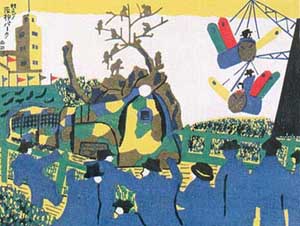Hanga Japanese Creative Prints

|

|
The focus of this exhibition is hanga (literally �block/plate picture�) as a new art medium of modern Japan. The word and concept of hanga emerged in the early 20th century as a child of Japanese modern culture with its catchword �individualism�.
The challenge for artists was to express their most personal feelings, aspirations and fantasies through the manipulation of the woodblock medium. Life, passion, death and the perplexities of the human condition were prevailing concerns for these artists as they sought to express their innermost thoughts. Life was hard for many of them as they struggled to make a living from their art � so much so that hanga was sometimes used as a pun for �hunger�.
Featuring over 130 images, including many major works from Japanese collections not previously seen outside Japan, this exhibition traces the development of this still unfamiliar Japanese print movement. It includes all the major artists of this movement, including woodcuts by the �grand master� of hanga MUNAKATA Shiko whose expressive prints are already known and admired internationally.
The prints are extraordinary not only through the very intimate engagement with the individual artists that we are offered, but because of the insight they give into the society and culture of the time, particularly the rising tides of socialism and nationalism in the pre-war period.
Presented chronologically, the prints cover the decades of the 1910s to the 1950s. The exhibition begins with the early works of ONCHI Koshiro, who was to represent the vanguard of the modern Japanese artistic consciousness for over 40 years in prints and other media with his commitment to individuality and his acute sensitivity to new artistic developments in the West. In his search to convey emotions which have no concrete form, ONCHI used the works and writings of Kandinsky, then becoming available in Japan, as a springboard for his own floating ephemeral fields of colour in which he attempted to create �poem-like images� using colour and form instead of words to express his joy, sorrow, hope and anger.
ONCHI was a poet as well as a print artist and his images are imbued with poetic allusions. The symbiotic relationship between poetry and image is a sub-theme to the exhibition, since most of these artists were closely involved with Tokyo literary circles, and published in magazines alongside the work of contemporary poets.
The exhibition culminates with the heart-rending, devastating images of war by HAMADA Chimei who had served in China in 1940. HAMADA preferred the medium of etching because it distanced the painful rawness of war memories, and his intensely disturbing prints comment not only on violent, physical death, but on the death of humanity.
The works in the exhibition are redolent with emotional intensity ranging from the joy of a first infatuation to the pain of war. It will provide viewers with a moving insight into a little known aspect of Japanese art.
|
| On view: | Saturday 28 October 2000 to Sunday 7 January 2001
Art Gallery of New South Wales
Art Gallery Road, The Domain, Sydney
| | Telephone: | Telephone (02) 9225 1744 or recorded information (02) 9225 1790
| | Hours: | 7 days a week 10am to 5pm
(closed Christmas Day)
| | Admission: | Free of charge | | Media Information and Interviews: | Jan Batten
Telephone (02) 9233 1213 or (0418) 279 348
janb@ag.nsw.gov.au
| Above: KITAMURA Imazo Hanshin Park in Autumn Colours1939
|
|